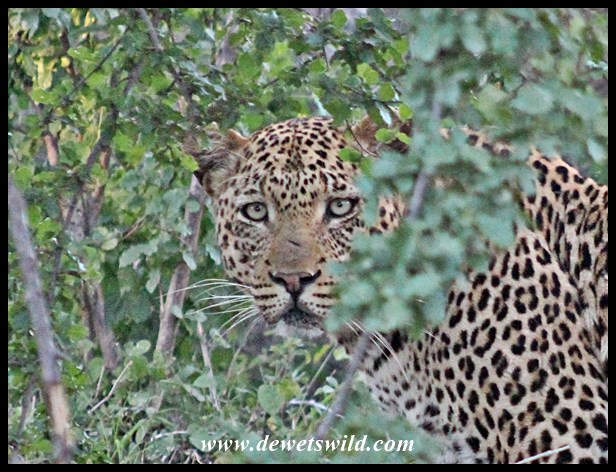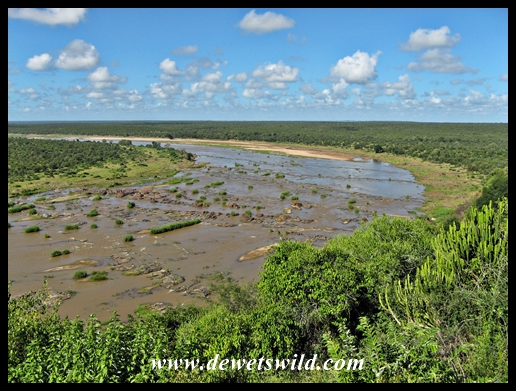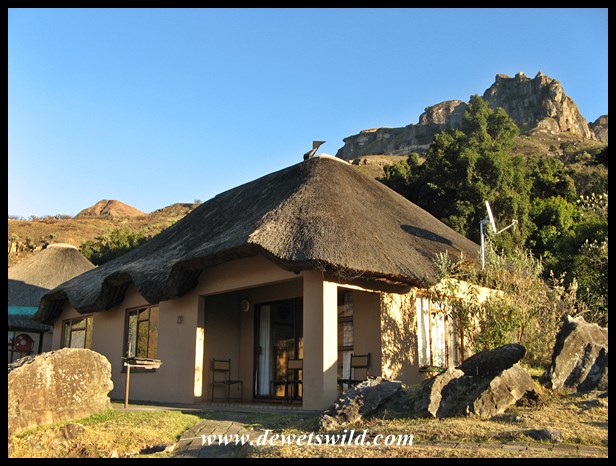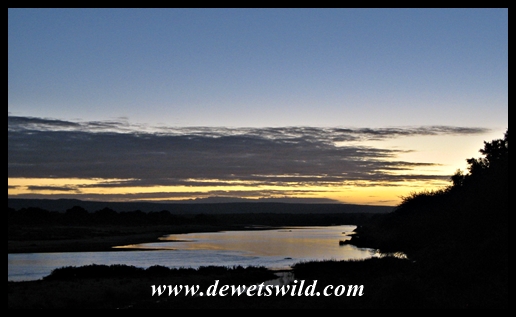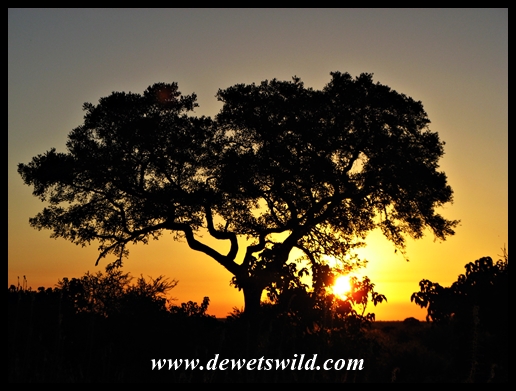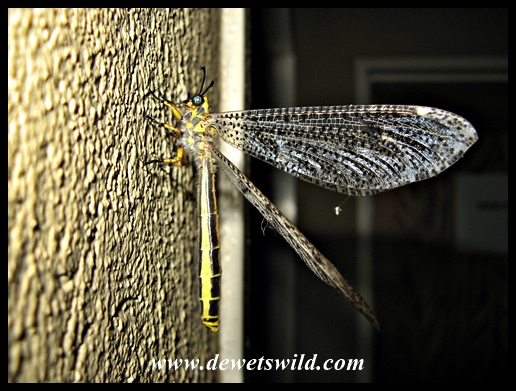After three nights at Lower Sabie it was time to move northwards to the central regions of the Kruger National Park. Just as we set off, a light drizzle started falling, and kept falling for the entire 50km or so distance between Lower Sabie and Tshokwane picnic site. While the low clouds meant that we could not enjoy the magnificent view from the top of Nkumbe mountain, we did not mind having a break from the previous few days’ oppressive heat! Pretty soon little puddles were forming on rocks and in the road, and while the shower would not have broken the drought, it would have brought a little bit of relief to the parched veld.

Giraffe under heavy skies

Zebra crossing a very wet road

Klipspringer ewe enjoying the drizzle

Wet waterbuck

Klipspringer ram on Nkumbe

Bushbuck ewe at Tshokwane

This trusting Golden-tailed Woodpecker distracted us from our breakfast at Tshokwane

Young kudu bull

Mazithi Dam was little more than a drying mud puddle crammed with tired hippos and flayling barbel

Grey duiker

Elephant cow in the dry bed of the Nwaswitsontso

Towering giraffe

Pair of Little Bee-Eaters
Between Tshokwane and Satara we encountered two more pairs of mating lions. While one couple moved away from the road for more privacy, the other was a lot more relaxed in the company of the few cars that had gathered to watch them. The prevailing drought makes catching prey much easier, and the way the lions are going on there will soon be many more young and hungry mouths to feed.

The loving couple

“All this attention is so boring”!

“Look at me posing”

“Come on, you’ve seen enough!”

Praying that we’ll leave them in peace
After lunch (take-away pizzas enjoyed in Satara‘s day visitors area) we tackled the final stretch of the long drive from Lower Sabie to Olifants Rest Camp. The plains between Satara and the Olifants River were positively teeming with wildlife of all descriptions.

Buffalo looking for fresh grass on the side of the road

Red-billed Buffalo Weaver in Satara

Big bull on the way to Olifants

At times Satara’s plains are reminiscent of the Serengeti

Ostrich siblings

Pod of hippos in the bed of the Olifants

Young kudu bull

Two tiny warthogs in a big, scary world
Checking in at Olifants Rest Camp, we were given the keys to our cottage, number 14, one of the most popular units in the camp, and for good reason. The view of the wide bend of the Olifants River with its pods of hippos and lurking crocodiles far below, the endless wild plains beyond and the continuous stream of game and birds arriving to slake their thirst, is almost unrivaled anywhere on the continent, and you can take it all in from the comfort of a sofa on the wide veranda!

Olifants Rest Camp, unit 14, December 2015

There aren’t many places with a view like this!
With the area around Olifants suffering from an extreme drought and intense heat, we thought it best to stick to the routes along the Olifants River and some of its tributaries that still held water for our afternoon drive. The high bridge and low-level causeway crossing the Olifants, and the weir at the Ngotso-crossing (on the S89 route) proved to be hot-beds of wildlife activity, though in the areas in between, away from the water, there were few animals to be found.

Hippos from N’wamanzi Viewpoint

Hippos from N’wamanzi Viewpoint

Yellow-billed Kite in low level flypast

Another pod of hippos at the Ngotso weir

Martial Eagle surveying his landscape

Waterbuck close-up

Showing just how the waterbuck got its name!

Egyptian Geese at the Balule causeway

Wood Sandpiper

This Free-tailed Bat came visiting after dark
Next morning we were already waiting, with a few other cars, at Olifants’ gate for the 04:30AM opening – that’s the way to maximise your chances of encountering large predators on the prowl in the hot summer and we didn’t have to drive far before encountering two spotted hyenas just as first light started painting the African morning. Our drive took us along the Olifants and Letaba rivers, an area of rugged beauty, to Letaba Rest Camp, where we planned on enjoying our picnic breakfast. We didn’t however bargain that we’d be joined by a snake, even if only a slightly venomous Olive Grass Snake. Happily the snake was very well behaved and totally relaxed, and so he enjoyed the warm morning sun while we enjoyed our rusks and coffee…

Spotted hyena close up

Hyenas always seem to be on the way to somewhere…

View over the Olifants River back towards the camp

Two kudu bulls in the bed of the Letaba

Letaba is well-known for the buchbuck in camp

Letaba’s relaxed bushbuck give excellent photo opportunities!

Our friendly breakfast Olive Grass Snake

Here elephants have right of way!

Baby impala in the mopane scrub
Seeing as the Olifants river delivered such enjoyable sightings to us the previous day, we again focussed on the H1-5 tar road and the connecting S90, S91 and S92 gravel roads the following afternoon. This time we worked a quick detour to Bangu waterhole, some distance to the south of the river, into our drive as well – a well rewarded decision as we found a pair of black-backed jackals and flock of Temminck’s Coursers at the Xipembane stream, which still held a bit of water.

Grey Heron

Yellow-billed Stork

Another old timer at Olifants

Black-backed jackal

Temminck’s Courser

Three-banded Plover
Driving up to Olifants two days earlier, the tremendous concentrations of game around Satara really drew our attention, and we decided that we had to explore that area a bit more on our final full day at Olifants. With the tarred road between Olifants and Satara carrying most of the tourist traffic, we opted to rather follow the gravel S90 “old main road”, past Bangu and Gudzani waterholes, to Satara, and then return to our lovely cottage at Olifants along the tar route when the day starts hotting up. Ticking excellent sightings along the way; a large pack of hyenas, showboating hippos, a rarely seen honey badger, two regal lions, more jackals and a quick view of a pair of cheetahs surrendering their kill to descending vultures, not to mention a huge number of more commonly seen birds and animals, and despite heavy cloud cover, a howling wind and the irritation of a punctured tire (quickly fixed at Satara’s car wash), you’ll appreciate that we were a very happy group when we arrived back at Olifants that morning!

Two very coy young hyenas

It’s been a long night…

Hippo posturing at the Balule causeway

Another lone old tusker

Just a sliver of light at the back of these kudus

Ostrich female being blown all over the place by the strong wind

Old buffalo

Honey badger on the hunt

Windblown Kings

Towering over the plains

Playful jackal pups
After spending the hot midday hours in camp appreciating the enchanting view and the accompanying birdlife, it was time for our final leisurely afternoon drive along the Olifants and Letaba Rivers. While the drive wasn’t anywhere as exhilarating as our drive that morning, it did give us another opportunity to enjoy the rugged scenery of the valleys these rivers have carved over aeons through the Lebombo foothills.

Female Red-winged Starling on her nest at our cottage

Wahlberg’s Eagle hunting from a perch near our cottage

Zebra grazing on new growth next to the Letaba

Giraffe in the mopane
We still had three nights left at Shingwedzi Rest Camp after our time at Olifants, and we’ll be telling you all about those next week. We’ll also be telling you more about Olifants and its environs in an upcoming edition of de Wets Wild.







































